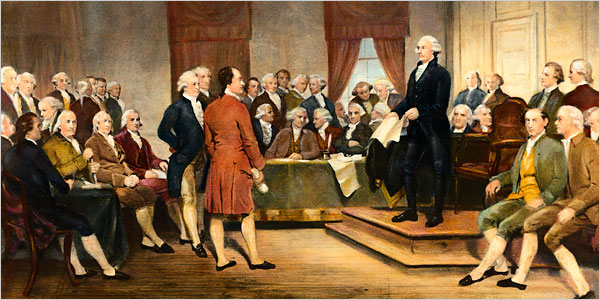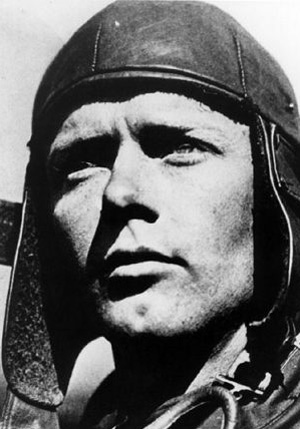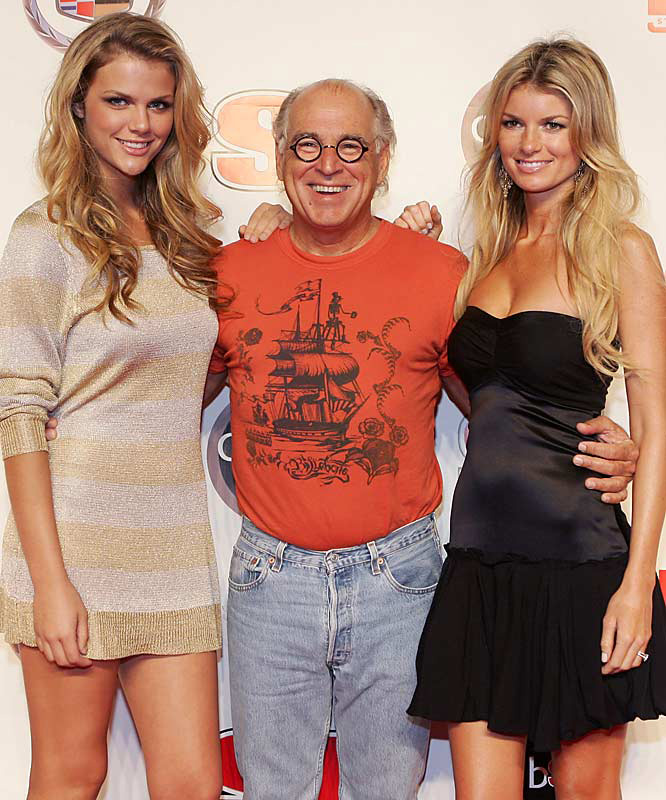The inspiration that led to the adoption of the English bulldog as the official Marine Corps mascot came from World War I-era German soldiers. Legend has it that the Marines were referred to as “teufel-hunden,” (“devil-dogs”), the vicious, wild mountain dogs of Bavarian folklore, because of the Marines’ relentless method of attack that turned the tide as the German Army approached Paris. In June 1918, the Marines repeatedly repulsed the Germans in Belleau Wood, ending the offensive to take the city. Soon afterward, a Marine recruiting poster painted by artist Charles B. Falls appeared depicting a dachshund, attired in a spiked helmet and Iron Cross, fleeing from an English bulldog wearing a helmet bearing the Marines’ globe and anchor insignia. The painting’s inscription read, “Teufel-Huenden—German nickname for U. S. Marines—Devil Dog Recruiting Station.”
The first officially enlisted Marine Corps mascot was an English bulldog christened Jiggs. Brigadier General Smedley D. Butler inducted him into the Corps as Private Jiggs with a formal ceremony on 14 October, 1922, at Quantico, VA. Eventually promoted to ultimate Marine rank, Sgt. Major Jiggs presented the Marine colors throughout the world, and was featured in the 1926 Lon Chaney film “Tell It To The Marines.” Upon his death in 1927, SgtMaj. Jiggs was interred with full military honors. His satin-lined coffin lay in state in a hangar at Quantico, surrounded by flowers from hundreds of Corps admirers.
• For decades, official mascots were called “Smedley” to honor their first inducting sponsor, Gen. Smedley D. Butler.
• “Chesty” became the most used named beginning in the 1950's, to honor legendary Lt. General Lewis B. “Chesty” Puller Jr.
• Chesty III was awarded the Good Conduct Medal for his behavior with children.
• Present mascot Corporal Chesty XI enlisted Aug. 24, 1995.
Motto:
Semper Fidelis; Latin for Always Faithful
Until 1871 it was "First to Fight", a motto that still applies.
Through the years, Marines have shortened it to Semper Fi, and "Semper Fi, Mac" is the universal Marine Greeting.
Seal:
The Marine Corps Seal, designed by the Marine Corps Uniform Board in accordance with instructions of the Commandant of the Marine Corps, then General Lemuel C. Shepherd, Jr., was adopted by Presidential Executive Order 10538 of 22 June 1954.
The traditional Marine Corps emblem-eagle, globe and fouled anchor-forms the basic device of the Seal. Of these three, the eagle and the fouled anchor are the most venerable, dating from 1800 when they first appeared on the Marine uniform button-a button which has remained to this day virtually unchanged from its original form. Influenced strongly by the design of the emblem of the British Royal Marines depicting as their domain the Eastern hemisphere, the U.S. Marines adopted in 1868 as their emblem a globe showing the Western hemisphere. To this was added the spread eagle and fouled anchor from the button. Twelve years later the motto, "Semper Fidelis," completed the design.
The scarlet and gold surrounding the emblem are the official Marine Corps colors. These in turn are enclosed by Navy blue and gold signifying the Marine Corps as an integral part of the naval team.
Emblem:
The history of the Marine Corps emblem is a story related to the history of the Corps itself. The emblem of today traces its roots to the designs and ornaments of early Continental Marines as well as British Royal Marines. The emblem took its present form in 1868. Before that time many devices, ornaments, and distinguishing marks followed one another as official marks of the Corps.
In 1776, the device consisted of a "fouled anchor" of silver or pewter. The fouled anchor still forms a part of the emblem today. (A fouled anchor is an anchor which has one or more turns of the chain around it). Changes were made in 1798, 1821, and 1824. In 1834 it was prescribed that a brass eagle be worn on the hat, the eagle to measure 3 1/2 inches from wingtip to wingtip.
During the early years numerous distinguishing marks were prescribed, including "black cockades, "scarlet plumes," and "yellow bands and tassels." In 1859 the origin of the present color scheme for the officer's dress uniform ornaments appeared on an elaborate device of solid white metal and yellow metal. The design included a United States shield, half wreath, a bugle, and the letter "M."
In 1868, Brigadier General Commandant Jacob Zeilin appointed a board "to decide and report upon the various devices of cap ornaments for the Marine Corps." On 13 November 1868, the board turned in its report. It was approved by the Commandant four days later, and on 19 November 1868 was signed by the Secretary of the Navy.
The emblem recommended by this board has survived with minor changes to this day. It consists of a globe (showing the Western Hemisphere) intersected by a fouled anchor, and surmounted by a spread eagle. On the emblem itself, the device is topped by a ribbon inscribed with the Latin motto "Semper Fidelis" (Always Faithful). The uniform ornaments omit the motto ribbon.
The general design of the emblem was probably derived from the British Royal Marines' "Globe and Laurel." The globe on the U.S. Marine emblem signifies service in any part of the world. The eagle also indirectly signifies service worldwide, although this may not have been the intention of the designers in 1868. The eagle they selected for the Marine emblem is a crested eagle, a type found all over the world. On the other hand, the eagle pictured on the great seal and the currency of the United States is the bald eagle, strictly an American variety. The anchor, whose origin dates back to the founding of the Marine Corps in 1775, indicates the amphibious nature of Marines' duties.
On 22 June 1954, President Dwight D. Eisenhower signed an Executive Order, which approved the design of an official seal for the United States Marine Corps. The new seal had been designed at the request of the Commandant of the Marine Corps, General Lemuel C. Shepherd, Jr.
The new seal consisted of the traditional Marine Corps emblem in bronze; however, an American bald eagle replaced the crested eagle depicted on the 1868 emblem, and is depicted with wings displayed, standing upon the western hemisphere of the terrestrial globe, and holding in his beak a scroll inscribed with the Marine Corps motto "Semper Fidelis" (Always Faithful) with the hemisphere superimposed on a fouled anchor. The seal is displayed on a scarlet background encircled with a Navy blue band edged in a gold rope rim and inscribed "Department of the Navy, United States Marine Corps" in gold letters. Coincident with the approval of this seal by the President, the emblem centered on the seal was adopted in 1955 as the official Marine Corps Emblem.
Reference Section History and Museums Division
Flag:
History of the Marine Corps Flag
Very little information is available regarding the flags carried by early American Marines, although indications are that the Grand Union flag was carried ashore by the battalion led by Captain Samuel Nicholas on New Providence Island, 3 March 1776. It is quite possible that the Rattlesnake flag was also carried on this expedition.
The standard carried by the Marines during the 1830s and 1840s consisted of a white field with gold fringe, and bore an elaborate design of an anchor and eagle in the center. Prior to the Mexican War, this flag bore the legend "To the Shores of Tripoli" across the top. Shortly after the war, the legend was revised to read: "From Tripoli to the Halls of the Montezumas."
During the Mexican and Civil Wars, Marines in the field apparently carried a flag similar to the national flag, comprised of red and white stripes and a union. The union, however, contained an eagle perched on a shield of the United States and a half-wreath beneath the shield, with 29 stars encircling the entire design. Beginning in 1876, Marines carried the national colors (the Stars and Stripes) with "U.S. Marine Corps" embroidered in yellow on the middle red stripe.
At the time of the Vera Cruz landing in 1914, a more distinctive standard was carried by Marines. The design consisted of a blue field with a laurel wreath encircling the Marine Corps emblem in the center. A scarlet ribbon above the emblem carried the words "U.S. Marine Corps," while another scarlet ribbon below the emblem carried the motto "Semper Fidelis."
Orders were issued on 2 April 1921 which directed all national colors be manufactured without the yellow fringe and without the words "U.S. Marine Corps" embroidered on the red stripe. This was followed by an order dated 14 March 1922, retiring from use all national colors still in use with yellow fringe or wording on the flag. Following World War I, the Army practice of attaching silver bands carrying inscriptions enumerating specific decorations and battles was adopted. This practice was discontinued on 23 January 1961.
Marine Corps Order No. 4 of 18 April 1925 designated gold and scarlet as the official colors of the U.S. Marine Corps. These colors, however, were not reflected in the official Marine Corps standard until 18 January 1939, when a new design incorporating the new colors was approved. The design was essentially that of today's Marine Corps standard.
For a brief time following World War I, the inscribing of battle honors directly on the colors of a unit was in practice, but realization that a multiplicity of honors and the limited space on the colors made the system impractical, and the procedure was discontinued. On 29 July 1936, a Marine Corps Board recommended that the Army system of attaching streamers to the staff of the organizational colors be adopted. Such a system was finally authorized by Marine Corps Order No. 157, dated 3 November 1939, and is currently in practice.
Reference Section
History and Museums Division
The Marines' Hymn:
It is the oldest official song in the U.S. Armed Forces. The words are dated from the 19th century. The music is from the opera, "Genevieve de Brabant" by Jacques Offenbach, which opened in Paris in 1859. The Marine Corps secured a copyright on the song on 19 August 1919.
Nicknames:
Leatherneck
This name originates from the stiff leather stock that early Marines wore around their necks, probably to protect their jugular vein against saber blows.
Devil Dog
The Germans after the battle at Belleau Wood in World War I called the Marines "Teufelhunden", which translates as Devil Dog, because of the fierce fighting that the Marines demonstrated.
Jarhead
This was a slang term used by sailors in World War II because Marines in their Dress Blues with the stiff collar resembled Mason Jars.
The President's Own
Gyrene
Formed from the combination of G.I. and Marine
America's (The World's) 911 Force
The Marine Corps has earned this nickname by being the first forces called in a crisis.
During the Cold War, Marines were called upon to protect our nation's interests on an average of once every 15 weeks. Since 1990, Marines have responded once every 5 weeks, an increase in tasking's by a factor of three.
***
Motivational Call - OOH RAH, OO RAH Marines hear it each and every day. Ingrained into Marine minds since boot camp, this distinctly Marine call is barked back and forth in an almost endless stream of motivation. However, take a step back and ask that Marine, "where did 'Oorah' come from exactly?" The answer is rarely the same. Countless stories abound regarding the mysterious origins of our beloved phrase.
However, unlike many Marine traditions, "Oorah" is rather new. As any veteran of the past 50 years would say, no Marine before 1950 could be found saying it. The true popularization of the word came in the '80s and '90s, when it fully emerged from the murky secrecy of Marine reconnaissance through drill instructors and by other means into use by Marines around the world.
"As far as I had been told, 'Oorah simply means 'let's kill,'" said Staff Sgt. Hugo Monroy, drill instructor for Platoon 1094, Delta Co., 1st RTBn. "As far as its origin, I really don't know. I always assumed it was simply a Marine tradition that was passed down from Marine to Marine."
The stories of "Oorah's" origins range from the logical to the absurd, including stories such as it being Turkish for kill, which is in fact цldьrmek, or even simply a direct counter against the Army's "Hooah."
But where did the word really come from?
Marines and historians have determined the true origins of "Oorah" lie with recon Marines stationed in Korea in 1953. During this time, reconnaissance Marines in the 1st Amphibious Reconnaissance Co., found themselves traveling via submarine to where they were needed. The memorable call of "dive, dive!" would be called on the intercom and a klaxon alarm, which made a very distinct "Aarugha" sound, would announce the descent of the sub below water.
The recon Marines, who heard this sound often, started using it as a motivational tool during runs and physical training. Over time, the word "Aarugha" came to be too much of a mouthful, and eventually molded itself into the familiar "Oorah," according to Maj. Gary Marte, a retired Marine.
Confirmation for this version of the story rests with the official Marine Corps Training Reference Manual on the history of Marine recon, titled "Aarugha," the manual gives credence on the origination of the phrase with reconnaissance Marines."Oorah" is just one of the things that separates Marines from any other branch of service, and has become a part of our lasting history.
"It is the traditions, the history, that makes Marines stand out," said Aulton Kohn, Parris Island Museum information receptionist. "The stories passed from drill instructor to recruit, and from Marine to Marine, they add the color to the Corps."
Corps Values:
HONOR: I will bear true faith and allegiance ...; Accordingly, we will: Conduct ourselves in the highest ethical manner in all relationships with peers, superiors and subordinates; Be honest and truthful in our dealings with each other, and with those outside the Navy; Be willing to make honest recommendations and accept those of junior personnel; Encourage new ideas and deliver the bad news, even when it is unpopular; Abide by an uncompromising code of integrity, taking responsibility for our actions and keeping our word; Fulfill or exceed our legal and ethical responsibilities in our public and personal lives twenty-four hours a day. Illegal or improper behavior or even the appearance of such behavior will not be tolerated. We are accountable for our professional and personal behavior. We will be mindful of the privilege to serve our fellow Americans.
COURAGE: I will support and defend..; Accordingly, we will have: courage to meet the demands of our profession and the mission when it is hazardous, demanding, or otherwise difficult; Make decisions in the best interest of the navy and the nation, without regard to personal consequences; Meet these challenges while adhering to a higher standard of personal conduct and decency; Be loyal to our nation, ensuring the resources entrusted to us are used in an honest, careful, and efficient way. Courage is the value that gives us the moral and mental strength to do what is right, even in the face of personal or professional adversity.
COMMITMENT: I will obey the orders ...; Accordingly, we will: Demand respect up and down the chain of command; Care for the safety, professional, personal and spiritual well-being of our people; Show respect toward all people without regard to race, religion, or gender; Treat each individual with human dignity; Be committed to positive change and constant improvement; Exhibit the highest degree of moral character, technical excellence, quality and competence in what we have been trained to do. The day-to-day duty of every Navy man and woman is to work together as a team to improve the quality of our work, our people and ourselves.
 John Penn
John Penn 











